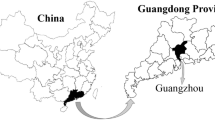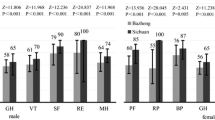Abstract
Aim
The aim of this study was to explore the quality of life (QOL) and its associated factors among Chinese rural elderly.
Subjects and methods
Analyses based on data from a longitudinal study, performed in Dangtu, a township in Anhui province. In all, 945 elderly people completed the two surveys in 2014–2016. Generalized estimating equations (GEEs) was used to explore the association between multiple factors and QOL of the elderly.
Results
The elderly had higher World Health Organization Quality of Life Instrument-Brief Version (WHOQOL-BREF) total score and scores for each domain at the second survey than the baseline. The results of GEEs showed that age, education level, economic status, drinking status and social support were positively associated with QOL of the elderly. However, Geriatric Depression Scale-15 (GDS-15) score and Activity of Daily Living Scale (ADLs) score were negatively associated with QOL of the elderly. In addition, gender was only associated with physical and environmental domains. Similarly, marital status was only associated with psychological and environmental domains. Household cohabitants was associated with social and environmental domains. Smoking status and diabetes were only associated with physical domain. Hypertension and stroke were associated with physical and psychological domains. Heart disease was associated with physical and social domains. Significant trends of WHOQOL-BREF total score were observed for the variables of age, education level, economic status, and ADLs score.
Conclusion
Multiple factors can affect the QOL of the elderly in rural China. These findings can provide guidance aimed at improving their QOL.

Similar content being viewed by others
Change history
30 January 2018
The journal had been advised to revise the title so that Clarivate Analytics can try to count the citations more accurately. There’s been confusion due to the existence of another journal with the same name.
Abbreviations
- QOL:
-
Quality of life
- GEEs:
-
Generalized estimating equations
- WHOQOL-BREF:
-
World Health Organization Quality of Life Instrument-Brief Version
- GDS-15:
-
Geriatric Depression Scale-15
- SSRS:
-
The Social Support Rating Scale
- ADLs:
-
Activity of Daily Living Scale
- OR:
-
Odds ratio
References
Baumann C, Erpelding ML, Régat S, Collin JF, Briançon S (2010) The WHOQOL-BREF questionnaire: French adult population norms for the physical health, psychological health and social relationship dimensions. Rev Epidemiol Sante Publique 58:33–39
Chan AC (1996) Clinical validation of the geriatric depression scale (GDS): Chinese version. J Aging Health 8:238–253
Chang YC, Yao G, Hu SC, Wang JD (2015) Depression affects the scores of all facets of the WHOQOL-BREF and may mediate the effects of physical disability among community-dwelling older adults. PLoS One 10:e0128356
Christensen U, Schmidt L, Kriegbaum M, Hougaard CØ, Holstein BE (2006) Coping with unemployment: does educational attainment make any difference? Scand J Public Health 34:363–370
Cleary KK, Howell DM (2006) Using the SF-36 to determine perceived health-related quality of life in rural Idaho seniors. J Allied Health 35:156–161
Dawalibi NW, Goulart RM, Prearo LC (2014) Factors related to the quality of life of the elderly in programs for senior citizens. Cien Saude Colet 19:3505–3512
Fogelholm M, Valve R, Absetz P, Heinonen H, Uutela A, Patja K, Karisto A, Konttinen R, Mäkelä T, Nissinen A, Jallinoja P, Nummela O, Talja M (2006) Rural-urban differences in health and health behavior: a baseline description of a community health-promotion programme for the elderly. Scand J Public Health 34:632–640
Forman DE, Berman AD, McCabe CH, Baim DS, Wei JY (1992) PTCA in the elderly: the “young-old” versus the “old-old”. J Am Geriatr Soc 40:19–22
Fusco O, Ferrini A, Santoro M, Lo Monaco MR, Gambassi G, Cesari M (2012) Physical function and perceived quality of life in older persons. Aging Clin Exp Res 24:68–73
Hellström Y, Persson G, Hallberg IR (2004) Quality of life and symptoms among older people living at home. J Adv Nurs 48:584–593
IsHak WW, Greenberg JM, Balayan K, Kapitanski N, Jeffrey J, Fathy H, Fakhry H, Rapaport MH (2011) Quality of life: the ultimate outcome measure of interventions in major depressive disorder. Harv Rev Psychiatry 19:229–239
Jylhä M (2004) Old age and loneliness: cross-sectional and longitudinal analyses in the Tampere Longitudinal Study on Aging. Can J Aging 23:157–168
Kharicha K, Iliffe S, Harari D, Swift C, Gillmann G, Stuck AE (2007) Health risk appraisal in older people 1: are older people living alone an “at-risk” group? Br J Gen Pract 57:271–276
Kindig DA, Booske BC, Remington PL (2010) Mobilizing Action Toward Community Health (MATCH): metrics, incentives, and partnerships for population health. Prev Chronic Dis 7:A68
Lasheras C, Patterson AM, Casado C, Fernandez S (2001) Effects of education on the quality of life, diet, and cardiovascular risk factors in an elderly Spanish community population. Exp Aging Res 27:257–270
Lawton MP, Brody EM (1969) Assessment of older people: self-maintaining and instrumental activities of daily living. Gerontologist 9:179–186
Li S, Xie Z, Shao J, Xiao C, Tian L, Zhao R, Gong J, Han J, Wang Y, Han C, Dang L, Zhang Y, Chen B, Luo X, Guo W (2012) Subjective well-being of the elderly in Xi Cheng District, Beijing. Shanghai Arch Psychiatry 24:335–346
Lima MG, Barros MB, César CL, Goldbaum M, Carandina L, Ciconelli RM (2009) Health related quality of life among the elderly: a population-based study using SF-36 survey. Cad Saude Publica 25:2159–2167
Lima MG, Barros MB, César CL, Goldbaum M, Carandina L, Alves MC (2011) Health-related behavior and quality of life among the elderly: a population-based study. Rev Saude Publica 45:485–493
Liu LJ, Guo Q (2007) Loneliness and health-related quality of life for the empty nest elderly in the rural area of a mountainous county in China. Qual Life Res 16:1275–1280
Liu T, Sun L (2015) An apocalyptic vision of ageing in China: old age care for the largest elderly population in the world. Z Gerontol Geriatr 48:354–364
Lv XL, Jiang YH, Sun YH, Ren CZ, Sun CY, Sun L, Wu ZQ, Zhao X (2013) Short form 36-Item Health Survey test result on the empty nest elderly in China: a meta-analysis. Arch Gerontol Geriatr 56:291–297
Marc LG, Raue PJ, Bruce ML (2008) Screening performance of the 15-item geriatric depression scale in a diverse elderly home care population. Am J Geriatr Psychiatry 16:914–921
Mitra M, Chung MC, Wilber N, Klein Walker D (2004) Smoking status and quality of life: a longitudinal study among adults with disabilities. Am J Prev Med 27:258–260
Peng X (2011) China’s demographic history and future challenges. Science 333:581–587
Rakhshani T, Shojaiezadeh D, Lankarani KB, Rakhshani F, Kaveh MH, Zare N (2014) The association of health-promoting lifestyle with quality of life among the Iranian elderly. Iran Red Crescent Med J 16:e18404
Ran L, Jiang X, Li B, Kong H, Du M, Wang X, Yu H, Liu Q (2017) Association among activities of daily living, instrumental activities of daily living and health-related quality of life in elderly Yi ethnic minority. BMC Geriatr 17:74
Reblin M, Uchino BN (2008) Social and emotional support and its implication for health. Curr Opin Psychiatry 21:201–205
Regan TJ (2000) Moderate alcohol consumption and risk of coronary heart disease among women with type 2 diabetes mellitus. Circulation 102:487–488
Sheikh JI, Yesavage JA (1986) Geriatric Depression Scale (GDS SF): recent evidence and development of a shorter version. Clin Gerontol 5:165–172
Skevington SM, Lotfy M, O’Connell KA, WHOQ Group (2004) The World Health Organization’s WHOQOL-BREF quality of life assessment: psychometric properties and results of the international field trial—a report from the WHOQOL group. Qual Life Res 13:299–310
Stenzelius K, Westergren A, Thorneman G, Hallberg IR (2005) Pattern of health complaints among people 75+ in relation to quality of life and need of help. Arch Gerontol Geriatr 40:85–102
Su PY, Hao JH, Xiong LM, Yu DD, Cao YT, Fang Y, Jiang XL, Qian QX, Tao FB (2011) The prevalence and influencing factors of abuse and negligence against elderly in rural areas of Anhui province (in Chinese). Chin J Epidemiol 32:110–115
Tuzun H, Aycan S, Ilhan MN (2015) Impact of comorbidity and socioeconomic status on quality of life in patients with chronic diseases who attend primary health care centres. Cent Eur J Public Health 23:188–194
van Oort FV, van Lenthe FJ, Mackenbach JP (2004) Cooccurrence of lifestyle risk factors and the explanation of education inequalities in mortality: results from the GLOBE study. Prev Med 39:1126–1134
Wang JL (2004) Rural-urban differences in the prevalence of major depression and associated impairment. Soc Psychiatry Psychiatr Epidemiol 39:19–25
Webb E, Blane D, McMunn A, Netuveli G (2011) Proximal predictors of change in quality of life at older ages. J Epidemiol Community Health 65:542–547
World Health Organization Quality Of Life Group (1995) The World Health Organization Quality of Life assessment (WHOQOL): position paper from the World Health Organization. Soc Sci Med 41:1403–1409
Xia P, Li N, Hau KT, Liu C, Lu Y (2012) Quality of life of Chinese urban community residents: a psychometric study of the mainland Chinese version of the WHOQOL-BREF. BMC Med Res Methodol 12:37
Zhao Y, Hu C, Feng F, Gong F, Lu S, Qian Z, Sun Y (2017) Associations of self-neglect with quality of life in older people in rural China: a cross-sectional study. Int Psychogeriatr 29:1015–1026
Acknowledgments
The authors would like to thank all participants and the persons who helped us in conduction of the research.
Funding
This study was funded by grants from the Talent Program of the Higher Education Revitalization Plan of Anhui Province, China, 2013 and the Major Program of the Social Science Foundation of Anhui Province, China, 2014 (SK2014ZD037).
Author information
Authors and Affiliations
Corresponding author
Ethics declarations
Conflict of interest
The authors declare that they have no conflict of interest.
Ethical approval
All procedures performed in this study were in accordance with the ethical standards of the Ethics Committee of Anhui Medical University (including study design and procedures) and with the 1964 Declaration of Helsinki and its later amendments or comparable ethical standards.
Informed consent
Informed consent was obtained from all individual participants for being included in the study.
Additional information
The original version of this article was revised: Due to the existence of another journal with the same name, the Publisher has added a subtitle, “From Theory to Practice.” Effective as of January 2018, the new title of this Journal is Journal of Public Health: From Theory to Practice.
A correction to this article is available online at https://doi.org/10.1007/s10389-017-0893-1.
Rights and permissions
About this article
Cite this article
Dong, B., Li, J., Zhao, D. et al. The associated factors for the quality of life among Chinese rural elderly: 1-year follow-up study. J Public Health 26, 185–193 (2018). https://doi.org/10.1007/s10389-017-0852-x
Received:
Accepted:
Published:
Issue Date:
DOI: https://doi.org/10.1007/s10389-017-0852-x




